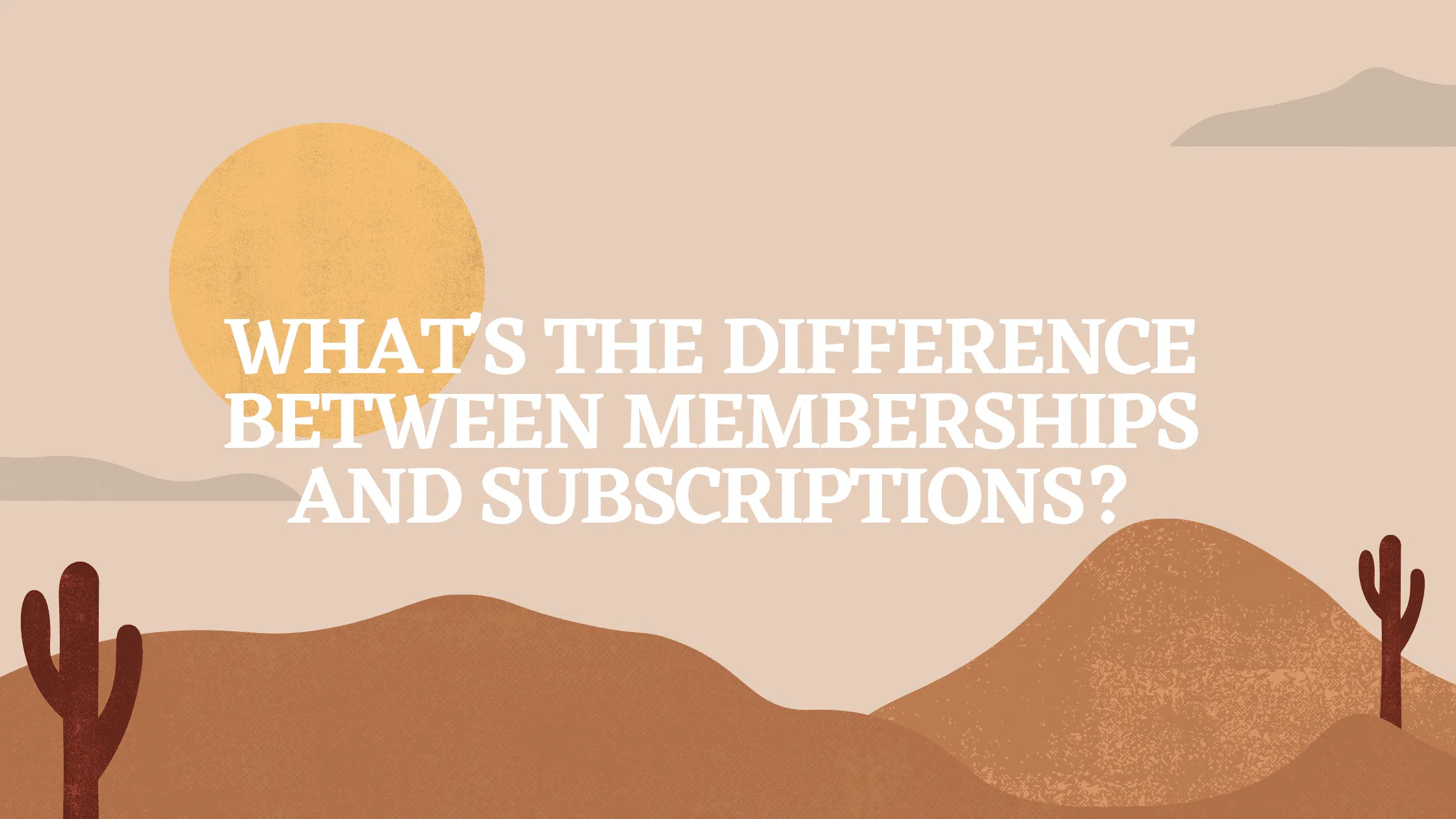When describing a business model based on recurring payments, the terms membership and subscription are frequently interchanged. People may refer to what is more appropriately described as a membership as a subscription, and vice versa.
These names technically refer to two distinct business methods. While there is no one-size-fits-all definition, you should think about the goal of each one.
Subscriptions, at their most basic level, allow a set level of monthly (or yearly) access to material, tools, or services in exchange for a recurring subscription charge.
Consider daily digital news subscriptions or weekly periodicals, for example. Subscribers stay engaged with these services on a regular basis because they receive a steady stream of content.
A subscription ensures that the customer receives a benefit on a regular basis.
Consider the following scenario:
- Entertainment
- Digital assets to use in their artistic endeavors
- Services that are beneficial to them in some way
- Consumable or usable physical items
Consider a gym membership or a library membership as an alternative. In some cases, the consumer not only obtains access to the gym or library but also becomes a member of a select group.
A sense of belonging is provided by the communal aspect of membership.
Memberships are particularly helpful in an online environment where businesses are constantly under pressure to retain clients and produce more money because of their community nature. In fact, for specific business categories, it may make or break the consumer experience.
Knowing the difference between a membership and a subscription can help you do the following:
- Determine how to expand your firm in a way that is consistent with your brand and business objectives.
- Maximize the value of your goods and services
- Make sure you’re giving the appropriate stuff to the right people.
All of these steps are necessary for establishing a successful online business. Choosing the incorrect model (or using incorrect language) can have a detrimental impact on your company by:
- Perplexing site visitors and causing buyer friction
- Misrepresenting what you have to offer
- Requiring resources or features that you are unable to supply
- Selling your goods or service at a lower price than it is worth.
Consider the case when you launch a membership program in your company without any infrastructure to support the development of a community. This would prevent your members from interacting with one another.
Without interaction, there would be little or no impetus for progress, resulting in a waste of time and resources. In this piece, we’ll look at the distinctions between memberships and subscriptions, as well as some pointers to help you pick the proper model for your company – and achieve your objectives.
Membership and Subscription Business Models
The subscription model’s purpose is to supply customers with a steady stream of material or access to a service in exchange for a recurring fee. Subscription businesses, such as Netflix, Amazon Prime, and Spotify, charge users a recurring monthly price to use their services.
The subscription model is gaining in popularity. According to Juniper Research, the global subscription economy is expected to rise by $51 billion by 2022.
On the other hand, memberships aren’t only about the product or service. The word “member” emphasizes the importance of belonging to a group and social network.
Memberships are about forming a community of people who have common interests and a knowledge network.
One of the most significant advantages of membership is that it gives a platform for people to:
- Interact with one another
- Exchange ideas
- Take pleasure in the advantages of a product or service
According to a survey on membership marketing by 2021 Marketing General, 63 percent of consumers join because they want to interact with their peers. Fizzle and AppSumo Plus, for example, are examples of memberships in which the community plays an important role.
Memberships and Subscriptions: What’s the Difference?
Although the terms membership and subscription are not interchangeable, membership models have a payment structure that is similar to subscription models. If you run a membership site, this implies you’ll almost certainly require your subscribers to pay a regular subscription fee.
Taking a Community-Oriented Approach
The purpose of memberships is to develop a strong network by focusing on the community. The viewer is offered exclusive information and significant relationships by becoming a member of such a group.
Because access to an exclusive group is one of the greatest selling features for the membership model, membership firms should concentrate their efforts on community building.
Subscriptions, on the other hand, are nearly totally focused on the client or the product. This implies you get special privileges when you subscribe to a service. You may not, however, gain access to a specific community.
When you buy a digital subscription to a magazine, for example, you receive access to the material but not to a community of readers who want to talk about it.
Customer Interaction
Customer involvement is the lifeblood of most internet businesses. According to Sitel Group, 75 percent of clients will cut ties with a company after a single bad experience.
As a result, giving an enhanced customer experience is one of the best methods to attract customers to return and buy again. This is why subscriptions and memberships are so popular.
However, depending on which model you choose, the greatest techniques to promote interaction vary.
It’s critical for subscription businesses to maintain or improve their content quality standards, such as adding new features and offering regular updates for digital products and services.
The most successful subscription businesses are those that enhance their content quality over time. Customers will remain interested and engaged as a result of this.
Conversations and focused sessions that help meet the audience’s demands are part of the customer engagement strategy for memberships. To add extra value to the client experience, you may offer learning opportunities via webinars, for example.
It’s also critical to adopt information distribution methods that allow consumers to participate in these discussions. If you want to enhance your membership community, focus on fostering dialogue as much as possible.
Frequency of Content
In the digital world, the success of both membership and subscription businesses is often dependent on regular, high-quality content generation. The quality of the content is equally crucial for memberships and subscriptions.
The rate at which you must create fresh content, though, differs between the two.
Depending on the type of business, a subscription service may not need to deliver content on a regular basis. Most subscriptions, on the other hand, would not be able to sustain without regular content releases because the ordinary user is used to high levels of consumption.
Netflix, for example, would fall behind its competitors if it did not release new material on a weekly basis. In fact, Netflix Originals were created in response to the growing demand for more audience-centered content.
Producing more material, however, should not imply sacrificing quality. A business’s subscriber base can soon dwindle if the quality of its material deteriorates.
Memberships, on the other hand, live on human engagement (as well as the quality of content). Members expect a membership company to provide them with resources and to assist them in forming and participating in a knowledge network.
Members may even assist in the creation of content for a membership business. As a result, the membership model’s expectation of content frequency is lower than the subscription model’s.
Management of Access
The basic principle behind a subscription is to attract as many consumers as possible and generate money based on that number. As a result, subscriptions are often available to anyone.
Spotify, for example, is available to everyone who pays a monthly subscription cost. It’s as simple as creating an account, paying the cost, and enjoying the content.
When it comes to access management, memberships take a different approach. After all, being a part of a community implies that each individual contributes some level of competence, information, or experience.
As a result, certain people are inevitably excluded from memberships. For example, if you’re a content creator who wants to learn more about this field, you’d only join Fizzle.
In addition, memberships must be moderated on a regular basis. All members must follow the membership’s general rules, which is why most businesses employ community moderators.
Marketing Techniques
Both memberships and subscriptions necessitate a user-centered approach that focuses on delivering tangible advantages rather than simply introducing more features. Their marketing techniques, on the other hand, tend to diverge.
Customers are typically attracted to subscription businesses by offering a trial period during which they can experience all of the subscription’s perks for a limited time. The customer’s perception of value and the quality of this experience leads to the purchase of a subscription plan.
Customers are typically attracted to membership models by offering trial or free memberships with limited access. Premium services, such as community access (which is often where members may gain the most benefit), are usually kept behind a paywall.
As a result, the quality of the trial or free membership, as well as the promise of joining an exclusive group, drive this marketing strategy.
Selecting the Most Appropriate Business Model
To survive and generate a sustainable cash flow, all modern firms require some type of competitive advantage. This is especially true in the case of online enterprises, where the competition is fierce.
When deciding between the membership and subscription models, think about what is best for your company. The following are important variables to consider:
• The company’s short- and long-term objectives
• The nature, demands, and spending capability of your target audience
• The amount and quality of content you can create
• Your ability to supply content to your customers on a regular basis
• The market’s current trends and competitors
• Financial, technological, and human resource resources are all available.
Also, Read:
The Differences Between Memberships and Subscriptions: Final Thought
We’ve discussed how the phrases membership and subscription apply to two separate business models, despite the fact that they’re commonly used interchangeably.
We’ve also discussed the differences in content development requirements, access management techniques, and marketing strategies between the two.




